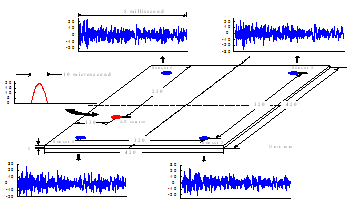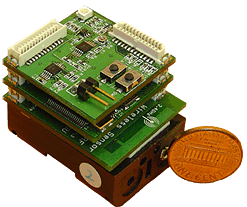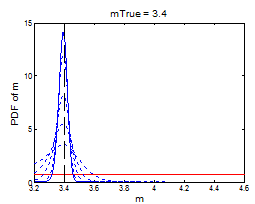Novelty
The novelty and uniqueness of the proposed technologies can be summarized into
the following thrust areas:
Thrust 1 | Thrust 2 |
Thrust 3 | Thrust 4 |
Thrust 5
Thrust 1: Flexible piezo paint sensing
dot array (Sensor Technology): The piezo paint sensor array will be established which is capable of
high-fidelity sensing of ultrasonic guided waves signals that will enable AE signalinterrogation for
structural integrity monitoring.
Novelty of proposed technologies: A flexible, high-fidelity piezo paint sensor developed
by the participating researchers at UMD will be capable of sensing wideband AE signals in complex bridge
structural components. Wideband signal is essential to inverse waveform analysis to quantify the AE source
(e.g., fatigue crack) characteristics. In particular, the proposed piezo paint sensor dot array will offer
a novel approach with a myriad of advantages suitable for fatigue crack monitoring.
Return to top of page
Thrust 2: Passive Interrogation of Evolving Damage
(AE Diagnostics): Successful development of the interrogation of acoustic emission (AE)
using time-reversal method will detect, localize, and tracing localized damage with high fidelity.
 |
|
Fig. 1: Four multiply
reflected sensor data under AE source |
Fig. 2: AE loading
history retrieved
by T-R method. |
Novelty of proposed technologies: A feasibility study to unravel the AE location and
AE loading time history using the T-R technique has been performed. An AE source is simulated by using an
electric hammer hitting at one point inside a finite plate. A network of four sensors that are
located near the corner of plate received the signal for the duration 50 ms shown in Fig. 1. The sensor
signals show complex waveforms due to over hundreds of boundary reflections. It can be seen that by using
the T-R method all the received signals have traveled back and refocused at the source location (not shown
here) and the loading history shown in Fig. 2 is almost fully recovered. These results showed that the T-R
method can be potentially used for illuminating the AE location and for recovering the original loading
history in complex civil structures.
Return to top of page
Thrust 3: Hybrid-mode Energy Scavenger (Energy Harvesting) to Power Wireless Sensor: Using a newly developed miniature wind turbine system (MWTS) supplemented with solar power, the harvested energy will power the wireless sensors and performed limited distributed signal processing for AE diagnostics.
|
|
Fig. 3: Miniature Wind Turbine system
to harvest wind energy. |
Fig. 4: Tested and predicted output
voltage
versus
resistive load |
Novelty of proposed technologies:We have conducted researches for energy harvesting using wind energy, specifically for applications in highways and bridges. A miniature wind turbine system (MWTS) composed of commercially available components was used for prototyping and verification to harvest energy from ambient airflow (Fig. 3). A 7.6 cm thorgren plastic propeller blade was adopted as the wind turbine blade. A maximum net efficiency of 14.8% and a maximum output power of 13.4 mW at a wind speed of 4 m/s (9 mph) was observed. A power density of up to 19 mW/cm3 at a wind speed of 8 m/s (18 mph) has been estimated (Fig. 4).
A hybrid-mode energy harvester utilizing wind power from MWT and solar energy will be designed to power the wireless sensors for on-board signal processing and wireless communication among wireless sensors.
Return to top of page
Thrust 4: Multi-media Wireless Smart Sensor (Wireless sensing): A low-power, processing-efficient wireless smart sensor will be developed to integrate with piezopaint sensing dotsfor sensing, diagnostics, and communication on bridges. Effective corrections for drift and bias will be automatically calibrated in the sensor.
 |
|
Fig. 5: A compact modularized high speed
wireless sensor platform developed by NCSU |
|
Novelty of proposed technologies:
Novelty of proposed technologies: We have developed the first wireless intelligent sensor platform (WISP) that is capable of sensing acoustic emission (AE) signals (e.g. sampling rate up to 10MHz) while maintaining low power consumption. The sensor platform (Fig. 5) has a dual-controller architecture and utilizes a FPGA (Field Programmable Gate Array) as a secondary controller to enable direct memory access. It has been verified that both power consumption and time duration for processing can be significantly lowered by improving I/O throughput.
Return to top of page
| |
 |
| |
Fig. 6: Updated distribution of material
parameter m for mtrue = 3.4 |
Thrust 5: Prognostics using Bayesian Updating (Prognosis): The Bayesian Theorem will be employed to update and inter-correlate the damage parameters associated with limit states for each class of civil structural components. The Paris law with two damage parameters will be used as the deterioration model for steel bridges with fatigue type of failure. By incorporating the probabilistic structural deterioration model with Bayesian updating, more accurately updated structural reliability and remaining useful life (RUL) will be evaluated and optimal maintenance strategies will then be made accordingly.
Novelty of proposed technologies: Very recently the participating researchers at NCSU initiated a prognostic algorithm for aging aircrafts (Coppeet al., 2009ab). Using Bayesian updating from five diagnostic damage images, the damage parameter m in the Paris damage evolution law, , rapidly converged with very narrow distributions (Fig. 6). With the updated m, the RUL in terms of number of fatigue cycles can be accurately predicted by

Thrust 1 | Thrust 2 | Thrust 3 | Thrust 4 | Thrust 5
Top of Page
|

